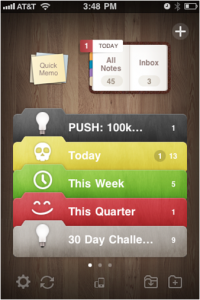Chalene Johnson's Blog, page 124
April 13, 2012
Creating Balance
Have you ever thought, “If I could just accomplish this one goal, I would be happy.”? But when you achieved your goal, you still did not feel the sense of satisfaction you thought you would? Oftentimes, this is a result of the important areas of your life being out of balance. For instance, if you’re having success in your career, but your relationship with your family is struggling; achieving yet another career goal most likely will not bring you happiness. Creating balance in your life is likely to bring you that happiness you are seeking.
Creating balance in the important areas of your life will enable you to feel a sense of satisfaction and inner peace. You can do this by evaluating your level of satisfaction in each of these areas and setting goals that will help you focus on areas that need your attention.
Creating Balance in the 10 Important Areas of Life
When writing out your list of 10 crazy cool goals for the year, take some time to evaluate the 10 important areas of life. You may realize that some of your goals need to be adjusted. Consider your level of satisfaction in the following areas:
Environment and your every-day surroundings
Time spent doing fun and leisure activities
Time spent doing activities that result in personal growth
Spirituality and faith
Your career and fulfilling your purpose or calling
Financial situation
Relationships with friends and family
Romantic relationship(s)
Health and fitness
Emotional health
Use this worksheet as a tool to help you with your evaluation.
As you look over this list, you may find that you are more satisfied with certain areas of your life than others. When you create (or recreate) your list of 10 goals for the year, adding some goals in the areas you feel less satisfied with help create balance in your life… and creating balance will likely result in a greater feeling of overall happiness and fulfillment.
April 10, 2012
Mastermind Groups: Take it to the Next Level
Amazing things happen when amazing people come together to help one another. If you really want to make things happen in your life and/or business, nothing can provide greater accountability than a mastermind group. Here's what mastermind groups are all about, why you need to get involved, and guidelines for making yours a success…
What is a Mastermind Group?
A mastermind is a group of people committed to pushing one another. It's a small group that meets on a regular schedule to push each other to reach set goals, evaluate each other's progress, network, and help one another grow their business or achieve whatever  goals they may have. Typically, masterminds are business-related, but really, these groups can be formed to reach goals of any kind.
goals they may have. Typically, masterminds are business-related, but really, these groups can be formed to reach goals of any kind.
On the business side, members typically range from experienced business owners to up and coming business owners and stay-at-home moms that want to turn a hobby into a business. The members may have similar or very different goals, but they are all brought together by "goal getting."
There is a "no excuses" mentality, and members are expected to show up to each meeting with their homework done. Masterminds provide substantial accountability; because the group checks in to ensure that you kept your word and completed your action items from the previous meeting.
 Why You Need to get Involved
Why You Need to get InvolvedA mastermind is an incredible source of accountability. When you commit to other successful people, you are much more likely to follow through than if you were to do it alone. The excitement of working with people who are creating momentum towards their goals will inspire you to continue moving forward as well. Ultimately, joining a mastermind will skyrocket your success.
Mastermind Guidelines
No matter where you live, you will find other individuals that are movers and shakers. If you're looking to join a mastermind group, Google "join mastermind," and include the name of your city in the search. You are likely to find something in your area. Another great resource for locating a group or getting ideas for your own group is www.lifehack.org. Whether you're looking to join an existing group or start one of your own, following the guidelines below will ensure your success.
Invite a variety of members to your group. Include up-and-comers, well-established movers and shakers, and people with varying levels of success. Members should include people from all walks of business from the newbie to the serial entrepreneur
 (someone who has started and grown several businesses with lasting success) to the professional.
(someone who has started and grown several businesses with lasting success) to the professional.Members should already be successful in one way or another. This doesn't mean they must already own a successful business – in fact, your group should include someone that is just getting started. It means these people should be "goal getters" – people that go after what they want and make things happen. They should be doers, action takers, and people that have an opinion (but not an overriding opinion).
Pick GOOD people – people whose morals and ethics you believe in, people you like and want to be around, and people you genuinely want to succeed.
Limit meetings to five to six people. (No more than 6.)
Masterminds are best when done in person.
Choose a person to be the leader of the mastermind meetings. They should keep the conversation moving and feel comfortable keeping people on task.
Meetings should be approximately an hour to an hour and thirty minutes.
Choose a start and end time for your mastermind group. I suggest starting a new group every 6 months. After working together for a period of time, you'll find that some members just won't take the steps to do what they need to do. By choosing a start and end date, you will have the opportunity to move on to group of new people with no hard feelings.
Surrounding yourself with "goal-getting" people will push you to reach your goals quicker that you could ever imagine. If you want to skyrocket your success and really start knocking goals off your list of 10, get yourself into a mastermind!
April 6, 2012
Get Fit with your Partner
People often ask me how to get their partner and/or their entire family on board when they decide to form healthier habits and adopt a fit lifestyle. Getting others to join you in your new, healthy ways works best when you include them in the process rather than forcing it upon them. Here are some tips to get your partner excited about adopting healthier habits.
3 Tips to Get Fit with your Partner
1.) Get on the same path – When you want your partner to join you in your efforts to get in shape, the best thing you can do is take steps to get on the same path. If you begin your fitness journey alone and exclude your partner from the process, you may create a disconnect. Starting something new and making changes to your lifestyle may make your partner feel as if they're no longer important, and resentment can build.
Instead, let them know your plan to get in shape, ask them to join you and lend you their support, and do it together. Make them feel important by letting them know that you really need them to help you stay accountable. Be sure to express your appreciation and say "thank you" any time they do act in a supportive manner.
2.) Let them choose the workout – If you want your significant other to join you in working out, your best bet is to let them choose the activity. Sure, it's great to invite them to come along when you take a fitness class or make a trip to the gym, but you will have greater success when you allow them to choose the workout. When you try to force your workout routine upon another person, they may not want to be a part of the process at all. Start out with an activity that your partner enjoys to get the ball rolling.
3.) Take Baby Steps – Gradually introduce healthier options. Start by making healthy foods look more appetizing and easy grab-and-go options:
Place healthier foods at eye level in the cupboard and refrigerator.
Keep fruits and veggies cut up in bowls and ready to eat.
Re-package large bags of food into individual serving sizes.
Arranging foods in this way makes it more likely for you and your partner to eat them than if they're tucked away and require preparation. You can also slowly introduce healthier options by swapping out your regular staples for something more nutritious. For instance, replace regular staples with sugar free and low fat items.
Remember to take baby steps. Doing a complete overhaul of the kitchen is likely to result in backlash. However, slowly making small changes makes the transition much easier.
March 28, 2012
Accountability: The Power of a Promise
Never underestimate the power of accountability and a public promise. Making promises to other people is a great way to hold yourself accountable to reaching your goals. Think about it – "I promise" is often only spoken when we are 100% positive that the outcome is within our control. Making a promise is making a commitment that you have the power to deliver on. Giving your word makes you feel personally, emotionally, and ethically responsible and committed to following through. So if you need some extra accountability, making a promise to someone you care about is likely to help you stay on track.

Whether it's to a friend or family member, making a promise to someone you care about helps you stay accountable to your goals.
Most of us are conditioned to put other people's needs ahead of our own. While it's easy to break a promise to ourselves, many of us would rather cut off our own arm before disappointing someone we care about. We consider it a reflection of our integrity. So, in order to create another layer of accountability for yourself, I want you to make a promise to follow through with your goals to the important people in your life.
Create Another Layer of Accountability
Here are some steps to help you make your public promise for greater accountability:
To hold yourself accountable for both your health related goals as well as all your other goals for the year, make one promise for your health goal and one for your PUSH goal. (You can view more information on PUSH goals here.) The right person to keep you on track may be different for each goal, so you create more layers of accountability by keeping them separate.
Make a list of the people who would feel some type of effect if you achieved your goal. Include that important person in your life whose opinion you greatly value.
Tell these important people your promise, explain why you made it, and give them permission to keep you on track.
Post your promise publicly. Share it on Facebook, Twitter, You Tube, whatever mode of communication you prefer. This way, you'll have tons of people in your network that know about your goals. If you share it publicly, you're much more likely to follow through.
Don't keep it to yourself! The more layers of accountability you have the better. Make your promise and proclaim it to the world now!
March 23, 2012
The Golden Reply: How to Stop being a Chronic People Pleaser
Are you a chronic people pleaser? This simple phrase will help you successfully manage and eventually cure your disease to please. Breaking myself of the people-pleasing habit has allowed me to be significantly more productive, enabled me to focus on my priorities, and it even helped me get over my fear of people thinking I was a jerk for saying no. You can do the same just by mastering the phrase above – The Golden Reply – and learning the rules to the "yes or no" game.
Why You're a People Pleaser
You're a people pleaser because you're a do-er. Everyone counts on you because you get things done. As a chronic people pleaser, you feel like you're letting others down by saying no or that by saying yes to everything you somehow become a hero. The people around you have become comfortable relying on you because you've said "yes" to so many requests and always pulled through.
While it's great to do things for other people, you have to do things for yourself, too. Oftentimes, a chronic people pleaser stops making time for his or herself and feels resentment, exhaustion, or a variety of other things as a result. But, you can't blame others for counting on you when you've conditioned them to do so by saying yes to everything. So instead, simply break this habit and cure your disease to please with The Golden Reply.
The Golden Reply
Here it is again…
 The Golden Reply: "Thank you so much for thinking of me. Let me check my schedule, and I'll get back to you."
The Golden Reply: "Thank you so much for thinking of me. Let me check my schedule, and I'll get back to you."
Memorize and practice using this phrase today. Using this reply gives you time to check your commitments and determine if saying yes actually makes sense. It also keeps you from having to say the word you fear saying most: NO.
Tips for Playing the "Yes or No" Game
Once you try The Golden Reply, you'll wonder why you didn't start using it sooner! Here are some rules to the "yes or no" game and tips on how you can use The Golden Reply most effectively:
Practice saying The Golden Reply and put it in your own words, so that it becomes a natural response.
There is no need to offer details or an explanation. People will rarely challenge you. If however, someone expresses disappointment in your response, ask yourself if this person really wants the best for you or if their purpose is self-serving.
When you're not 100% sure if you should say yes or no, review your list of priorities and see if it fits. Why are you considering saying yes?
Do things for other people when it feels good, makes sense, and fits with your priorities – not when it compromises them.
Each time you do say yes to something, you should say no to something else. Avoid letting your plate get too full. When you put something on your plate, take something else off.
Ask yourself, "Is this the best use of my time?"
If you feel misplaced guilt for saying no, review your list of goals and priorities for reassurance.
Put The Golden Reply into effect today. Not only will you feel an immediate sense of relief, but you will also have confidence in knowing that you're spending your time doing things that align with your big picture.
March 19, 2012
Being ON a Diet vs. HAVING a Diet
"You are what you eat" – we hear this phrase all the time. If you read last week's blog about applying the 80/20 rule not only to your goals but also to your nutrition and fitness, you saw that this saying is pretty accurate. 80% of your physical results come from your nutrition, while only 20% of your physical results come from exercise. That being said, if you want to see results, your nutrition is super important. For many people, the nutrition part means going on a diet, restricting calories, having limits, and being miserable. But really, it means having a diet you can live with and enjoy. It's time to redefine the term "diet," learn the difference between being "on a diet" versus "having a diet," and make a transition between the two.
Restrictive Diets Work… But Only Temporarily
 The truth is, diets sell – people always seem to be looking for the next big dieting trend that will bring them the results they're looking for. First, carbs are the enemy, then, they're eating nothing but grapefruits, and then it's a liquid diet. Diets are big sellers because generally, people want the work done for them. They want to be told what to eat, when, and how much; they want rules, restrictions and limitations. They think of dieting in terms of having a finish line and go from one extreme to the other: either they're on a diet that's restrictive or eating everything in their path.
The truth is, diets sell – people always seem to be looking for the next big dieting trend that will bring them the results they're looking for. First, carbs are the enemy, then, they're eating nothing but grapefruits, and then it's a liquid diet. Diets are big sellers because generally, people want the work done for them. They want to be told what to eat, when, and how much; they want rules, restrictions and limitations. They think of dieting in terms of having a finish line and go from one extreme to the other: either they're on a diet that's restrictive or eating everything in their path.
Yes, these restrictive diets work… but only temporarily. You can't live on grapefruits, and life will always present you with situations where you need to make healthy choices on your own. Not to mention, going to these extremes is horrible for your metabolism.
This is not a one-time deal, and there is no one-size-fits-all eating plan. We all have different tastes. What works for one person might not work for another. This is why it's so important to find a diet that works for you – one you can maintain, enjoy, and live with – so you have a diet instead of being on a diet.
Are you "ON a Diet" or do you "HAVE a Diet"?
So, would you rather be a chronic dieter or someone that manages a healthy weight and has a healthy relationship with food? Let's compare characteristics of being on a diet versus having a diet as I discuss further in my book Push.
ON a Diet
HAVE a Diet
Dieters have strict rules, beliefs, and self-imposed deprivation…and that deprivation fuels an intense desire to overeat and indulge in "forbidden foods."
Having a diet means being a habitually healthy, clean, and careful eater. Eating healthy is a habit, not an obsession.
Foods are labeled as "good" or "bad," and the bad foods are forbidden. Pleasure and food do not coexist.
Careful eaters look forward to their meals and habitually enjoy foods that provide nutritional value. While some foods are a rare treat, nothing is all out banned.
People on a diet second-guess themselves wondering if they ate the right foods or ate too much.
Careful eaters know when they've had enough and when they can afford to have a little extra.
Dieters focus on what they cannot eat and plan their day around foods they must avoid.
Careful eaters have control and know their numbers. They have a general idea of where they're at with their calorie intake throughout the day and how much they can afford to eat.
Making the Transition from Chronic Dieter to Careful Eater
Now that we've compared these two different relationships with food, let's discuss how you make the transition from being a chronic dieter to someone that is a careful eater. There are 3 basic steps to help you make this transition.
3 Steps to Transition from "Being on a Diet" and "Having a Diet":
1.) Educate yourself about nutrition – The more you learn about the nutritional value of food and the benefits it has for your body, the more inclined you will be to make healthier choices. Making healthy choices gives you confidence and motivates you to make even more healthy choices. You just have to get the ball rolling.
2.) Establish your goals and priorities – Often times, your relationship with food is a reflection of how you feel about yourself. To change your feelings about food, you need to change the way you feel about you. Spend some time establishing your goals and priorities and discovering what it is you really want out of life to improve this relationship.
3.) Confront your issues – Random eating and severely restricting food is often used as a distraction from other issues or thoughts. However, these thoughts are what really need to be addressed. Seeking professional help to deal with emotional needs and past traumas is a big step in having a healthier relationship with food.
Making this transition from being on a diet to having a diet and a healthy relationship with food is totally possible. It's just a matter of educating yourself and deciding to form better habits. Start today!
March 16, 2012
Simple Strategies for Creating a Better To Do List
The average person's To Do List exists on sticky notes, the backs of envelopes, or in their minds. Sure, some days, they might get through everything they planned, but most days, this method won't cut it. I have a proven formula for keeping a To Do List, and it's 100 times easier and more effective when you implement it on a smart phone. Your smart phone can take you from the kind of person who is somewhat scattered and occasionally keeps a To Do List to the kind of person that is organized, calm, and has it all together.
 Your Unloading Dock
Your Unloading DockThink of your To Do List as your unloading dock. It's impossible to remember everything that comes up throughout the day. I couldn't even remember where I parked when I went to the gym this morning. To remember important things, they have to be recorded. You have so much on your mind already. A mental To Do List simply won't do.
And yes, while you could implement these rules I'm about to share with you to the To Do List you keep on your calendar or the notepad in your purse, I want to encourage you to keep it on your phone. Face it, our cell phones are practically an extension of who we are: we carry them 24/7. Why wouldn't you keep your list of the important things you need to do on your phone and with you at all times?
Our Phones are an Extension of who we are
The average American checks their phone between 24 and 50 times per day. If you already check your phone at least once an hour to begin with, imagine how much more productive and focused you'd be if you were reminded of the to do's and goals you're working toward as often as you check your phone. What we think about most becomes our reality. If you keep your To Do List on your phone, and you check it frequently, your goals remain at the forefront of your mind. So, do yourself a big favor, and keep your To Do List on your phone.
5 Basic Steps for To Do List Success
With that said, my proven formula for successful To Do Lists can be summed up in 5 basic steps. I've found that people keeping To Do Lists are most productive and get more done in less time by following the steps below. Here's the good news: you'll already have 2 of the 5 steps covered just by keeping your list on your smart phone!
1. Create your To Do List at the same time every day – When you do something at the

Smart Phone To Do List App – AwesomeNote
same time every day, it becomes part of your routine – like brushing your teeth. Make creating a To Do List part of your every day routine to stay organized and get more done.
2. Maintain your To Do List in the same place – Keep your To Do List on your smart phone, and you've already got this one covered! By keeping your list in the same location, you always know where to find it and can access it easily. If your To Do List is on sticky notes scattered around your office or throughout the house, you will feel scattered, too.
3. Carry your list with you at all times. – Since your To Do List is your unloading dock, you'll use it to record important things that come up as you go about your day. If your To Do List is not with you, you can't write down the important things that come up – it becomes just one more thing you have to remember to do later. Your phone is with you at all times, so keeping your list on your phone will enable you to add important tasks as soon as they come up.
4. Begin your list with 3 items related to your Push Goal and 3 related to your health goal. – Tackling three small tasks each day related to your Push Goal and your health goal will provide you with accountability and enable you to reach those goals much more quickly. Completing small, bite-sized tasks gives you a sense of accomplishment, and brings you a step closer to your big goal.
5. Review and revisit your list several times per day. Checking your list frequently helps you stay focused and on task. When you get distracted by the things around you, reverting back to your list will help you move from task to task more quickly.
Taking a few minutes to plan out your day can save you up to 3 hours of unproductive time later. Practice the steps above to make creating a To Do List a habit. Keep your list on your smart phone, and before long, you'll be the most productive person you know!
March 12, 2012
Applying the 80/20 Rule – Do More Faster
Most people have heard of the 80/20 rule in regards to business, finances, and productivity, but did you know this is really a universal rule that can be applied to just about anything? The Pareto Principle states that "80% of all effects come from 20% of all causes." More generally, 20% of everything you do is responsible for 80% of your successes.
While the 80/20 rule is highly effective in business and financial situations, it's also highly effective when applied to your goals, your nutrition and fitness. Applying this single rule to these three areas will enable you to be more productive, achieve more in less time, and get quicker results. Here are the keys to using the 80/20 rule in each of these areas of your life…
The 80/20 Rule and Your Goals
In my book Push, I tell readers to make a list of 10 goals and identify one (or two) that will create the most momentum in helping all the others happen. Ding, ding, ding! This is the 80/20 rule at work! Accomplishing this goal – their Push Goal – will enable them to accomplish many of the other goals on their list. Some tips for applying the 80/20 rule to your goals:
When it comes to your goals and even your daily To-Do List, identify the 20% that counts and focus there first.
More-efficient actions should take the highest priority when planning your day.
This doesn't mean ignore the other 80%, but it does mean you need to focus on your 20% first.
Ask yourself, "Is this the most important thing I could be doing right now?"
Remember, you can't do EVERYTHING. So, just get really good at doing the important stuff first.
Applying the 80/20 Rule to Nutrition and Fitness
The 80/20 rule works a little differently when applied to nutrition and fitness – the rule is actually reversed. 80% of your physical results will come from your nutrition, and 20% of your results will come from exercise. This concept can be difficult for many people; it takes discipline. However, that doesn't mean you have to torture yourself trying to be perfect 100% of the time. Here's what you should shoot for:
Aim to eat clean 80% of the time. Give yourself a little wiggle room, but no more than 20% of the time should you eat outside of your target zone.
Instead of stuffing yourself to the point of no return, stop eating when you're 80% full.
If you have to choose between nutrition and fitness, nutrition takes higher priority.
Just because 80% of your results will come from nutrition doesn't mean you can ignore the 20% that comes from exercise. Get your workouts in!
Regular exercise makes sticking to a healthy diet much easier.
Plan to exercise 9 out of 10 days.
While applying the 80/20 rule to your goals versus your nutrition and fitness varies, this universal principle will bring the same result: success. Isn't it a relief to know you don't have to be perfect? Use the 80/20 rule as your guide, give your best, and anything is possible!
March 8, 2012
Have More Energy – 9 Golden Energy Rules
I love this quote: "The single biggest difference between people who get what they want and people who don't is energy." (via Psychotherapist and Clinical Director Mira Kirshenbaum). So often I hear people complain about not having enough energy to reach their goals and that they need to have more energy to do all things they want to do in life. But did you know that the amount of energy you have has more to do with your mindset than anything else?
If you're upset with the way things are going in your life, if you feel like you have bad luck or there's a lack of opportunities available to you, but you want do to more, here's the good news: YOU CAN! It all starts with you, your energy, and your attitude. You have total control over the amount of energy you have. To have more energy, you simply need to develop habits to create and protect it.
9 Golden Energy Rules to Have More Energy
Remember, the amount of energy you have is up to you! Here are 9 Golden Energy Rules to keep in mind and implement:
1.) Energy begets energy: Take a moment to think about the people you spend most of your time with. Are they positive, energetic people, or are they lazy, Debbie Downers? We feed off the energy of the people around us. If you want to have more energy, start hanging out with people that are movers and shakers.
2.) Energy is a decision: Again, energy has more to do with your mindset than anything else. It's just like when you play hooky at work and call in "sick." You work up your best sick voice to call your boss, and before you know it, you're wondering, "AM I really sick?" Our minds have an amazing ability to convince our bodies how we feel. If you tell yourself you're tired, you will be. DECIDE each day that you are awake, alive, and have all the energy in the world. You will instantly feel a difference!
3.) Premium fuel creates premium performance: It's true: you are what you eat. If you put crap in your body, you're going to feel like crap, too. Food is fuel. Choose foods that will fuel the rest of your day. Veggies, red fruits, and whole foods are the way to go!
4.) Strength and endurance require rest: To have more energy in your workouts and improve your strength and endurance, you need rest. Be sure to get enough sleep, so "I'm too tired," isn't your excuse to miss your workouts.
5.) Sleep is the ultimate fuel: Get to bed earlier at night, to be more productive during the day. Sleep does wonders for the body! It boosts mental ability, improves loss of body fat, slows the aging process, and improves healing. If you struggle to get to sleep at a decent time, gradually start making your bed time a little earlier by about 15 minutes every few days until you're getting the recommended 8 hours a night.
6.) Language (vocal and physical) attracts energy: Express your feelings and match your message with your voice. A voice with vocal inflection attracts energy, while a flat, monotone voice leaves you feeling…flat. Body language works the same way. It's hard to feel energetic when you're slouching in your chair. Sit up straight with your shoulders back and have confident body language to instantly have more energy, improve your focus and improve your mood.
7.) Energy is valuable and must be protected: There are many people out there who are energy suckers and Negative Nancies. Protect your energy by refusing to spend time with people that bring you down.
8.) Emotion ZAPS energy: Hitting extreme emotional highs and lows really takes a tool on your energy, too. To have more energy, try to keep your emotions in check as you move throughout your day. Don't stress over the little things.
9.) Energy requires a physical outlet: Nervous energy requires a physical outlet. When you feel nervous energy building up, channel it into your workouts or practice some type of calming activity like using a stress ball or tapping. Both (especially working out) are great ways to release stress.
March 5, 2012
3 Basic Fitness Facts for Creating Your Customized Workout Routine
Ultimately, the best workout is the one you'll do. We all have different likes, wants and needs, and these must be taken into consideration when creating your own customized workout routine. However, science should always be your guide.
As much as I love incorporating current fitness trends into my workouts to make them more fun and exciting, when it comes down to it, science is my foundation. When creating your own workout routine, let science be your guide and take the following basic fitness facts into consideration to get the best results.
1. Everybody's Different
Again, we all have different needs. What works for one person may not work for another. There are a variety of individual variables that affect exercise, and they include:
Age
Weight
Dieting history
Genetics
Medical conditions
Injuries
Gender
Workouts work best when they are tailored to these individual differences. Remember your personal fitness objectives and be sure to take them into consideration when creating your own workout routine.
2. You Need Change to Create Change
In exercise science, you often hear about the overload principle. This is a process of training that addresses how your body responds to change and incorporates exercises that will create improvement. It involves placing a greater "load" on the body, so that the body changes by making adaptations in response to this load.
In other words, to see changes in your body, you need to make changes to your workouts. When we challenge our bodies, our muscles and hearts rise to the occasion and naturally become stronger.
You can make changes to your body and your workout routine by increasing the intensity or duration of the exercise you're doing. You must make your regular exercise routine tougher, longer and more challenging than what you're doing now to see results.
3. Adaptation Avoidance
Adaptation is the body's ability to predict what's coming next. Our bodies are incredible machines! They automatically adjust and adapt to meet the physical demands placed on them. Bottom line: the more frequently we do an activity, the less effective it becomes.
So, to avoid exercise adaptation, increase your duration or intensity and gradually create change every 30 days. Try adding weighted hand gloves or high-intensity interval training to your workout routine. Keep your body guessing to avoid adaptation and hitting a plateau!







